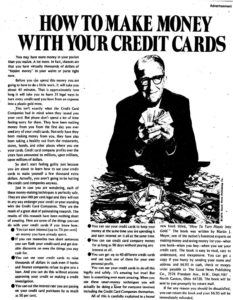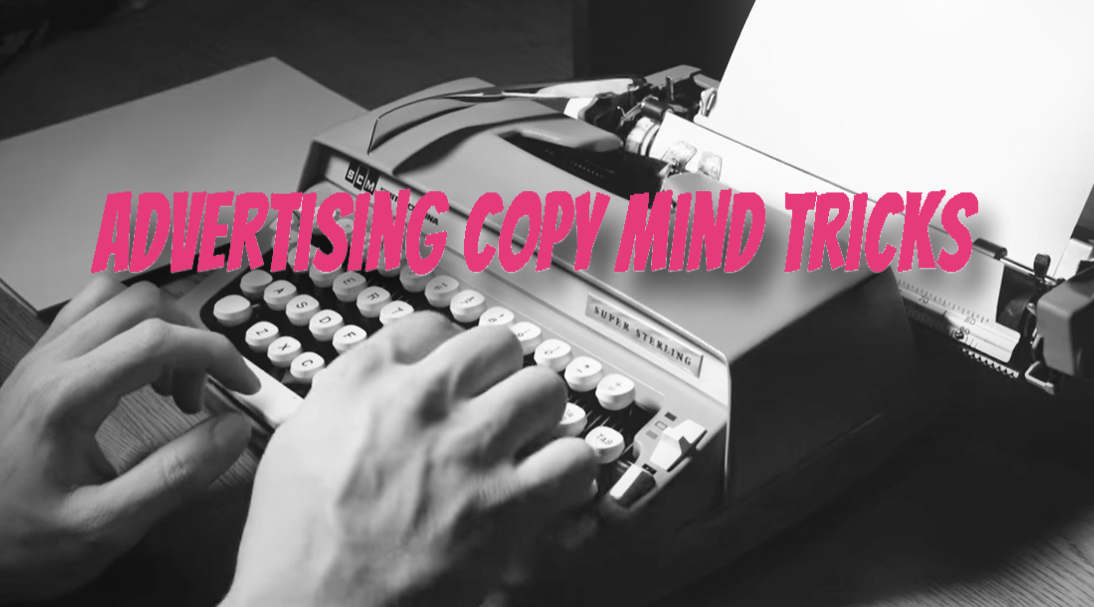The best advertising copy has psychological mind tricks.
Years ago, I ignored some good advice; I was told to read as many books on the psychology of selling as I could.
Since I snubbed that suggestion, it took me longer to learn how to write decent copy.
The good news is you can use these ideas for all kinds of copywriting tasks. Writing online sales pages, email campaigns, landing pages, blog posts, or other persuasive writing.
This post will analyze a sales letter by one of the world’s most famous copywriters. It will help you understand some of the mind tricks involved in writing a decent sales advertisement.
These psychological mind tricks are easy to learn and remember. If you practice and implement these ideas, your sales copy will bring in more money and convert at a much higher rate.
Not only that, but you can use these suggestions for all kinds of copywriting tasks. Writing online sales pages, email campaigns, landing pages, blog posts, or other persuasive writing.
Why We Are Analyzing This Advertising Copy
This ad was written by one of the world’s most successful copywriters, Gary Halbert.
I could give you a list of all of Mr. Halbert’s successes, let me say it as simple as possible: He eventually sold his business for over $75 million.
Another unique thing about him is he could write sales copy for a wide range of subjects; most copywriters have only 2 or 3 niches they write for.
Gary Halbert didn’t seem to have any barriers to copywriting subjects.
The advertisement we will analyze is How to Make Money with Your Credit Cards. This advertising copy was written in the 1970s and appeared in financial and opportunity magazines.
Of course, it pulled in a considerable amount of money for the business that ran the ad.
There are several reasons why I picked this advertisement.
First, it is not very long, and is only a one-page ad and not a long sales letter. Long-form sales letters outperform shorter ones in a direct mail campaign. Since this was written for a one-page ad, it was limited by space.
However, analyzing a long sales letter would probably take up a 5,000-word post. I know you don’t have the patience for that, so I decided to write about something more concise. Also, this is a proven piece that ran in magazines, so its value has been validated.
Here is a copy of the advertisement. Please read through it at least two times.

Another reason I chose this ad is I am very familiar with it. I have studied it considerably and written it out by hand ten times. If you want to get good at writing sales copy, this is a way to practice.
The Contradictory Headline
The headline is the most vital element of advertising copy. How to Make Money with Your Credit Cards is a simple yet powerful title.
It uses the psychological angle of curiosity and contradiction at the same time.
Most adults carry credit cards, even back in the 70, so this is a headline that appeals to almost everyone.
The contradiction is that credit cards are used to make money instead of spending it. To most of us, the term credit card means spending. Making an income with a credit card is a contradiction, enough to raise any reader’s curiosity level.
Also, the words How to Make Money had been successful in thousands of advertising campaigns.
With a mere eight words you have a headline that makes the average person curious enough to read further. Add the large, bold type and an image of a man with a pile of moola, and you have hooked your reader.
The First Paragraph
The first paragraph is almost as important as the headline. Once again, you have got to get readers interested enough to scan the page.
You may have more money in your pocket than you realize. A lot more. In fact, chances are you have virtually thousands of dollars of “hidden money” in your wallet or purse right now.
A tactic Gary Halbert employed was getting people to imagine positive images in their minds. The use of future pacing is the psychological trick here. Using the phrase – thousands of dollars of “hidden money” conjures up an image in a reader’s brain.
Getting a prospect to see something exciting in their mind is an easy way to hook them. This means there is a good chance they will read further.
As I mentioned before, this ad ran in magazines about making money. The idea that you have money that you did not know about is enticing.
Another mind trick in this paragraph is personalizing the copy. The first word in the ad is the word, you. This places the reader in the driver’s seat and makes them feel as though they are experiencing the scenario.
Adlucent, a marketing agency, collected data on this idea and found that 71% of consumers preferred personalization.
This is one of the reasons why you get so many marketing emails and direct mail pieces with your name on them.

Create a Villain in Your Copy
The more intimate you can become with your reader – the better.
One way to become more personal in your copy is to create a villain or common enemy.
People love being on the side of a cause, and they also enjoy having an enemy to rail against. In the case of this advertisement, the enemies are the credit card companies.
But please don’t spend a lot of time feeling sorry for them. They have been making money from you from the first day you ever used one of your credit cards.
You do not want to complain overtly about your chosen villain.
In other words, don’t say, “I can’t stand these mother-grabbers because they suck you dry with high-interest rates.”
In creating his villain, Mr. Halbert just started mentioning facts.
– They make money from you from day one
– Credit card companies make money from everyone
– They make millions upon millions upon millions of dollars
You don’t always need to have an enemy who is a person or company.
In the case of a diet product, sugar and fat are your enemies. For a roofing contractor, high winds and storms could be the villains. If you are selling SEO services, not having the knowledge could be an adversary.
There are a few reasons why this method works so well.
First, it operates on a subconscious level. In your mind, you know that the enemy is there, and now you have someone who has experienced the same thing. So you feel a connection.
I love the way Gary got a good jab in without sounding insensitive.
You aren’t going to be hurting the credit card companies anyway…
Also, having a villain in your copy will cause an emotional reaction. If you can point out exactly who or what is causing pain or problems in a prospect’s life, they will feel a subconscious bonding with you.
But here’s the thing…
You must know what it is your readers feel threatened by. If you don’t know what is bothering them, your copy will not convert well, and very few people will respond to your offers.
If you do your research on the front end, you’ll know what keeps them up at night.

Removing All Barriers in Your Copy
When writing advertising copy, you want to remove all barriers or resistance to objections. You have to admit, using credit cards to make money will make people skeptical or cautious. Telling people to fart around with high-interest credit cards will not be popular.
When Gary Halbert wrote this piece, he had to know that this is barrier he would need to overcome. So without bringing up that obvious obstacle, this is how he gets around it:
Just in case you are wondering, each of these money-making techniques is perfectly safe. They are also 100 per cent legal, and they will not in any way endanger your credit or standing with the Credit Card Companies. They are the result of a great deal of painstaking research.
Any worries you have are quickly reduced by phrases like perfectly safe, 100 percent legal, and will not in any way endanger your credit.
Near the end of the ad, Gary further removes the reader’s skepticism with this:
You can use your credit cards to do all this legally and safely.
And then he tells you them that they would actually be doing the credit card companies a favor by using these money-making tactics.
Use Repetition to Reinforce Your Message
The theme of this advertising copy is making money with credit cards. Of course, everyone wants to know how to make money. In order to psychologically reinforce that message, repetition of the idea is used.
I have listed all the words in this ad related to becoming profitable with credit cards:
– Make Money with Credit Cards
– plastic gold mine
– they have been making money
– make yourself a few thousand extra dollars
– money-making techniques
– earn interest
– sizable discounts
– raise thousands of dollars in cash
– cut interest rates
– keep your money
– use credit card company money
– your own personal profit
– smart-money techniques
– making money and saving money
I’m probably missing a few of these phrases, but you get the idea.
The hard part of using repetition in your copy is to use it subtly.
If you go back through and reread this copy, you’ll see what I’m talking about. It repeats the theme of making money over and over cleverly.
Anybody Can Do This
There are different ways you can tell a prospect they can get the results they want. In this ad, Gary mentions it will take them 45 minutes to learn 31 techniques.
Think about that for a second. Who cannot learn to do a task or strategy in 45 minutes?
Notice he doesn’t say, “Hey, any moron can do this.”
He merely states how long it will take them to learn it. This a method of overcoming another objection; the idea of not being smart enough or having enough time.
Here are more examples in this advertising copy:
If you can memorize two short sentences…
Or how about this one:
The book is easy to read, easy to understand…
Another way copywriters can imply this is by using the luck technique. (Even though this tactic is not in this ad, it is worth mentioning.)
For example, if you imply you were lucky to find a solution to your problem, then anyone can do it.
You can imply luck without coming right out and saying, “Hey, I was lucky.” You could say, “I bumped into a friend who had the solution…”, or “I just happened to find the answer online…”
Whenever you imply luck, you’re informing your readers that they can do it too.

Scare Them with Scarcity
When I started learning copywriting, I almost bought an expensive course from a famous copywriter. This guy was one of the best, and he wrote an entire page telling you that he was retiring.
He said he was getting rid of his courses, swipe files, money-making tactics, etc., and take his grandkids fishing and his wife on trips.
I read that sales page almost 15 years ago, and he’s still running it and hasn’t retired.
This is a tactic of creating scarcity in your copy. If there is an implication that readers won’t be able to get a product or service later, more people will jump on the offer.
Mr. Halbert only used this tactic once in this advertisement. The reason why he did not use it more is because he was limited by space on the page.
But here is the line he used near the end:
You can get a copy if you hurry…
Of course, this is the basis for most sales you see in the marketplace. Nothing will get some people into a store faster than a sale that advertises the scarcity of a product.
Here are a few of the ways you can create scarcity in your copy without being too obvious.
You can mention:
– Limited supply
– How many you have left
– It’s only for certain people
– By invitation only
– Exclusive memberships
– Only allow so many people
– Going out of business
– If you qualify
Many offers on the Internet use countdown clocks to show you how much time you have left on an offer. However, if the clock is not valid, prospects will figure it out.
So, if you use scarcity in your marketing, try to make it legitimate. Tell your prospects to give you their email addresses and you’ll let them know if an opening appears again.
Conclusion
There are other mind tricks in Gary Halbert’s advertising copy you could uncover. I merely pointed out the most obvious tactics he used.
As I mentioned earlier, if you study the psychology o f marketing and sales, there are lots of ways you can improve your advertisements, blog posts, email campaigns, and sales pages.
There are also all sorts of books on this subject. Here is one that is very interesting: Persuasion: Psychology of Selling: Secret Techniques to Close the Deal Every Time by Robert Moore.
If you want a copy of that book, you better hurry because it’s out of print. (Ha-ha! Gotcha, good buddy.)
Hey, analyze this advertising copy further and send me your findings in the comment box below; it would make my day.
